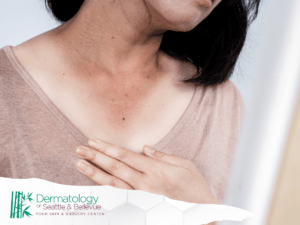One of the most crucial aspects of maintaining healthy skin is paying close attention to any changes that may occur. Both skin cancer and common skin issues like pimples can manifest as alterations in your skin’s appearance, but recognizing these changes early is essential for timely intervention and proper care.

Common Types of Skin Cancer Symptoms
Skin cancer is a serious health concern, and recognizing its symptoms is crucial for early detection and effective treatment. While there are several types of skin cancer, the most common ones include Basal Cell Carcinoma (BCC), Squamous Cell Carcinoma (SCC), and Melanoma. Each type has distinct symptoms that individuals should be aware of.
Basal Cell Carcinoma (BCC)
- Unusual Bumps or Patches: BCC often appears as flesh-colored, pearly bumps or patches that may bleed and develop a crust. They can resemble open sores that do not heal.
- Shiny Pink Growth: A shiny, pink, or red growth with an elevated border and central indentation can be a sign of BCC.
- Scar-Like Area: Sometimes, BCC can resemble a scar-like area that is firm to the touch. It may be yellow, white, or waxy in appearance.
- Blood Vessels: In some cases, fine blood vessels may be visible within the BCC lesion, giving it a spider-like or “telangiectasia” appearance.
Squamous Cell Carcinoma (SCC)
- Persistent Scaly Patch: SCC often begins as a scaly, red patch of skin that may crust or bleed. It can be mistaken for a non-healing sore.
- Elevated Growth: As it progresses, SCC may develop into an elevated, firm bump or nodule with a central depression.
- Wart-Like Appearance: Some SCC lesions can have a wart-like appearance, with a rough surface and raised borders.
- Tender or Painful: SCC can sometimes cause pain, tenderness, or itchiness in the affected area.
Melanoma
Melanoma is the most aggressive form of skin cancer, and early detection is crucial for successful treatment. It’s characterized by the ABCDEs:
- Asymmetry: Melanoma lesions are often irregularly shaped, with one half not matching the other half.
- Border: The borders of melanoma are typically uneven, jagged, or poorly defined.
- Color: Melanomas can display a variety of colors within the same lesion, including black, brown, blue, red, or white.
- Diameter: A melanoma is usually larger in diameter than a common mole, typically exceeding 6 millimeters.
- Evolution: Any changes in size, shape, color, or symptoms (itching, bleeding) should be promptly evaluated.
It’s important to note that these are general symptoms and characteristics associated with each type of skin cancer. Skin cancer can manifest differently in each individual, and not all cases will exhibit all these features.
Early detection of skin cancer significantly improves the chances of successful treatment and minimizes the risk of complications. If you notice any of these symptoms or have concerns about changes in your skin, it’s essential to seek medical evaluation from a dermatologist or healthcare provider.

Pimple Characteristics
Pimples, on the other hand, are common skin blemishes caused by clogged hair follicles. They often appear as small, raised bumps on the skin and can be associated with the following characteristics:
- Whiteheads: Closed, small bumps with a white center.
- Blackheads: Open comedones with a dark, oxidized plug at the center.
- Papules: Small, red, inflamed bumps.
- Pustules: Similar to papules but with pus at the tip, giving them a white or yellow appearance.
- Cysts: Larger, painful lumps filled with pus that may require medical attention.
Key Differences to Note
While skin changes associated with both skin cancer and pimples can be concerning, there are key differences to keep in mind:
- Duration: Pimples often come and go relatively quickly, while skin cancer signs may persist or worsen over time.
- Pain: Pimples can be painful, especially if they become inflamed, but skin cancer signs like bleeding or itching are typically more persistent and severe.
- Changes: Skin cancer often presents with significant changes in existing moles or the appearance of new, irregular growths. Pimples typically remain consistent in appearance or gradually improve.
- Risk Factors: Consider your risk factors. If you have a history of excessive sun exposure, family history of skin cancer, or other risk factors, it’s essential to be vigilant.
Skin Changes That Require Medical Attention
- Persistent Changes: If you notice skin changes that persist for several weeks or months without improvement, it’s a clear sign that medical attention is needed. Pimples often resolve within a relatively short time, while skin cancer signs tend to linger and may worsen.
- If a mole or skin spot bleeds, oozes, itches, or hurts, see a doctor to get it checked. These symptoms can be indicative of skin cancer, especially melanoma, and should not be ignored.
- A skin doctor should check new moles or growths on your skin, especially if you’re over 40. While not all new moles are cancerous, a medical professional can determine if further assessment is required.
- Changes in Existing Moles: Existing moles that undergo changes in size, shape, color, or texture should be examined promptly. Medical advice is essential if a mole becomes irregular in appearance or exhibits uneven borders.
- Dark streaks or lines can be a sign of melanoma, a serious type of skin cancer. They may appear in a mole or on the skin. Unusual pigmentation should be evaluated by a dermatologist.
When to Seek Medical Advice
If you notice any skin changes that concern you, don’t hesitate to seek medical advice from a dermatologist. Early detection of skin cancer is key to successful treatment. Your skin’s health is important – prioritize it today.









